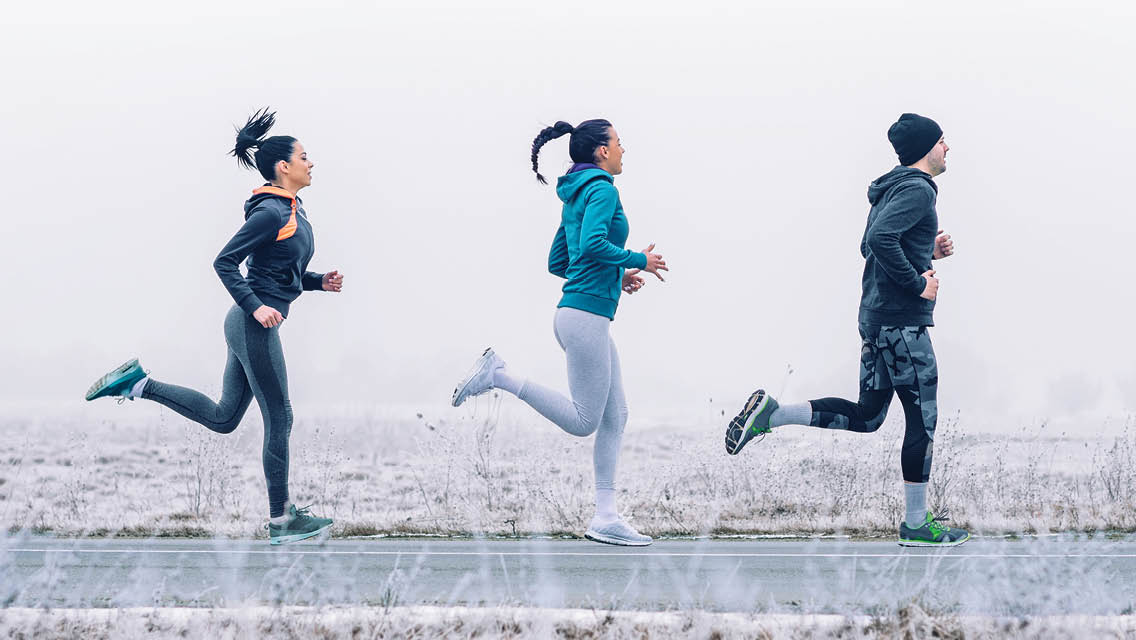For many, ice skating isn’t a year-round activity — but when temperatures drop, few winter pursuits seem to fit the season as perfectly. Still, pulling on a pair of skates, especially as an adult, can be intimidating if you don’t know what you’re doing.
If you feel more shaky than graceful, learning new skills to tweak your on-ice form, off-ice fitness, and overall mindset can help you capture the joy in gliding across frozen surfaces — and help you stay fit for other activities, too.
“Ice skating is a full-body workout,” says competitive figure skater Kelly Cassity, now the Learn to Skate coordinator at the Utah Olympic Oval. “Trying to balance on a 4-millimeter-thick blade requires balance, determination, and coordination.”
The biggest mistake adults make, she explains, is stiffening up out of nervousness when they step onto the ice. That makes falls even more painful, because your tense muscles aren’t able to absorb impact as well. Keeping your knees bent, staying low to the ice, and learning how to fall and get back up will take you far.
Off the ice, skaters can work on balance and core strength before practicing edging, crossovers, and other drills on the ice.
Learning these fundamentals will pay off, says Cassity. “There’s a sense of pride and satisfaction from going out and doing something that’s difficult. Plus, skating can be very social, so it’s a great way to connect with fellow adults.”
Skating is also an ideal way to develop endurance, says former college hockey player Andy Ness, current coach at Minnesota-based ProEdge Power and skating and skill coach for the Minnesota Wild. “Once you learn to skate well, you can exercise on the ice almost anywhere,” he says.
Cassity and Ness share these simple tips and drills to help recreational skaters enjoy the ice.
Beginner Ice Skating Drills and Technique Tips
Drill 1: Stretching
Limber muscles mean not only more-fluid movements on the ice, but also fewer (and less painful) falls, says Cassity. She recommends the following lower-body stretches, which you can do at home as part of your training. Every day, after a short dynamic warm-up, such as jogging or jumping jacks, practice these moves.
- Supine Hamstring Stretch: Lie on your back with both legs straight. Lift up one leg and hold the back of your thigh, calf, or ankle for support. Keeping both legs fully extended, draw your raised leg toward your head so you feel a stretch in your hamstring; don’t pull to the point of pain. Use a resistance band or towel looped around your foot for added support. Hold for one to two minutes for each leg.
- Hip-Flexor Stretch: Stand with feet staggered, the front foot 3 to 4 feet in front of the rear foot. With hands on hips and core braced, allow the back heel to lift while bending the front knee directly over the toes. Lunge down, keeping your chest up and front shin vertical. Straighten the back leg and squeeze your glutes to feel a stretch in the front of that hip. Hold for 30 seconds on each side.
Drill 2: Balance
This drill builds the strength and balance needed to stay upright on the ice, explains Ness. Three times a week, add this three-part move to your exercise routine.
- Stand on the curved side of a BOSU ball with feet hip distance apart. Squat with hands in front, elbows bent, and palms facing forward. Maintaining the squat, move your hands to the left and right, rotating your torso and head in the same direction. Repeat 10 times in each direction.
- Stand up on the BOSU ball, then lift your right foot and tap it down to the floor on the right side. Return to the center and repeat with the left leg. Complete 20 reps, alternating sides.
- With your right foot on the BOSU ball, extend your left leg behind you about 2 to 3 feet, so your left toes are on the floor, heel lifted. Bend your knees to perform a lunge. Complete 10 reps and switch to the other side.
Drill 3: Falling and Getting Up
Learning how to fall correctly will help protect you from injury when you tumble unexpectedly, says Cassity. The key is to land on a more muscular part, not on your hands. Start by practicing off the ice, first without skates and then with skates on. Next, move to the ice and fall from a standstill, while moving slowly, and then while skating more quickly.
- Wearing gloves and wrist guards, put your hands in front of you and bend your knees slightly and squat.
- Fall to the side, cushioning the impact primarily on your butt, hip, or upper arm.
- To get back up, use your hands to reposition yourself on all fours.
- Place one foot between your hands, and then the other.
- Stand up slowly, keeping the glutes squeezed and knees bent for stability.
Drill 4: Edging
Confidence on the ice comes from developing good balance and strength on your blade edges, says Ness. Once you can skate with stability, begin each rink session with this drill.
- Skate from one end of the rink toward the other. After three strides, turn in a small circle on one leg, focusing on balancing on the outside edge of the skate.
- Skate forward again for three more strides and repeat on the other leg. Remember to bend your knees, drop your hips, and stay low to the ice.
- Alternate legs, gradually increasing your strength and stamina to complete five trips up and down the ice.
Gear Essentials
Many ice-skating rinks rent out hockey skates because they’re more durable and stable than figure skates. Once you’ve learned the basics, you can choose between hockey skates and figure skates, which are more lightweight.
CCM Senior Tacks 1092 Ice-Hockey Skates
A stable, warm pick for beginners and amateurs. $80 at www.dickssportinggoods.com.
Jackson Ultima Excel Figure Skates
A basic pair for advancing your skating skills. $100 at www.dickssportinggoods.com.
Lack Diamond Half Dome Helmet
Protecting your noggin is a great idea, even for recreational skating. $60 at www.blackdiamondequipment.com.
Zoombang Padded Wrist Guards
Protect your wrists with these guards, which slip easily over the hands to fit under gloves. $16 at www.figureskatingstore.com.
This originally appeared as “Cutting Edge” in the January-February 2019 print issue of Experience Life.





This Post Has One Comment
This article is so helpful! I am 50 years old and have not skated forever! We have a large neighborhood pond that we cleared for skating and I have been too scared to get out there. I am going to use these training techniques described in the article so I can get my butt out there and do some fun exercise! Thank you,